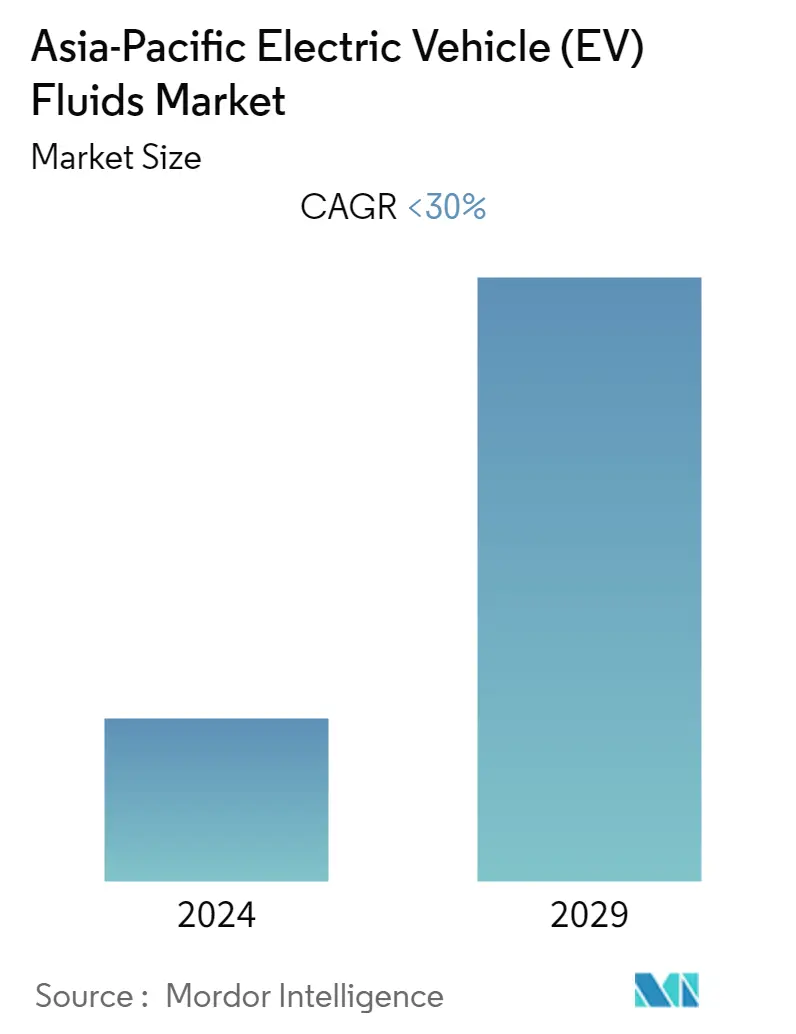Market Size of Asia-Pacific Electric Vehicle (EV) Fluids Industry

| Study Period | 2019 - 2029 |
| Base Year For Estimation | 2023 |
| Forecast Data Period | 2024 - 2029 |
| Historical Data Period | 2019 - 2022 |
| CAGR | < 30.00 % |
| Market Concentration | Medium |
Major Players_Fluids_Market-Market_Concentration.webp)
*Disclaimer: Major Players sorted in no particular order |
Asia-Pacific Electric Vehicle (EV) Fluids Market Analysis
The Asia-Pacific electric vehicle (EV) fluids market is expected to register a CAGR of over 25%, during the forecast period.
The market was hampered by the COVID-19 pandemic, as lockdowns, social distances, and trade sanctions triggered massive disruptions to global supply chain networks. The automotive industry, including sales and manufacturing of electric vehicles,witnessed a decline due to the halt in activities. However, the condition recovered in 2021, which was expected to benefit the market during the forecast period.
- Major factors driving the market studied are the increasing demand for electric vehicles and
- The high cost of purchasing an electric vehicle is expected to hinder the growth of the market studied.
- Increasing government initiatives to promote the sale of EVs is likely to act as an opportunity in the future.
- China is the dominant country in the Asia-Pacific region due to the rise in electric vehicle sales.
Asia-Pacific Electric Vehicle (EV) Fluids Industry Segmentation
EV fluids are lubricants that have been designed and developed specifically to suit the needs of electric vehicles. EV fluids keep the electric vehicle's powertrain and transmission system cool. The functions of the EV fluid include heat transfer, lubrication of EV parts, energy loss reduction, and improving the transmission system. The electric vehicle (EV) fluids market is segmented by product type, propulsion type, vehicle type, and geography. By product type, the market is segmented into engine oil, coolants, transmission fluids, greases, and other product types. By propulsion type, the market is segmented into battery electric vehicles (BEVs)), hybrid electric vehicles (HEVs), and plug-in hybrid electric vehicles (PHEVs). By vehicle type, the market is segmented into passenger vehicles, commercial vehicles, and other vehicle types. For each segment, the market sizing and forecasts have been done on the basis of revenue (USD million).
| Product Type | |
| Engine oil | |
| Coolants | |
| Transmission Fluids | |
| Greases | |
| Other Product Types |
| Propulsion Type | |
| Battery Electric Vehicles (BEVs) | |
| Hybrid Electric Vehicles (HEVs) | |
| Plug-in Hybrid Electric Vehicles (PHEVs) |
| Vehicle Type | |
| Passenger Vehicle | |
| Commercial Vehicles | |
| Other Vehicle Types |
| Geography | |
| China | |
| India | |
| Japan | |
| South Korea | |
| Rest of Asia-Pacific |
Asia-Pacific Electric Vehicle (EV) Fluids Market Size Summary
The Asia-Pacific electric vehicle (EV) fluids market is poised for significant growth, driven by the increasing demand for electric vehicles and supportive government initiatives. Despite initial setbacks due to the COVID-19 pandemic, which disrupted supply chains and led to a decline in automotive activities, the market has shown resilience and is expected to expand rapidly. China stands out as a dominant player in the region, with substantial investments in EV production facilities and a strong push towards electric vehicle adoption. The rise in hybrid electric vehicle preferences, fueled by stringent emission regulations and a shift towards low- or zero-emission vehicles, further propels the demand for EV fluids. Countries like India and Thailand are also emerging as key markets, with government policies and incentives promoting the adoption of electric and hybrid vehicles.
The market landscape is characterized by a partially consolidated structure, with major companies such as 3M, Afton Chemical, and FUCHS playing pivotal roles. Strategic collaborations, like those between Shell plc and CASTROL LIMITED with Chinese manufacturers, highlight the ongoing efforts to enhance EV fluid offerings. These partnerships aim to support the growing range of electric vehicles and meet the increasing demand for specialized fluids in the region. As the market continues to evolve, the Asia-Pacific region is expected to witness a robust increase in the consumption of EV fluids, driven by the expanding electric vehicle market and the ongoing transition towards sustainable transportation solutions.
Asia-Pacific Electric Vehicle (EV) Fluids Market Size - Table of Contents
-
1. MARKET DYNAMICS
-
1.1 Drivers
-
1.1.1 Increasing Demand for Electric Vehicles
-
1.1.2 Other Drivers
-
-
1.2 Restraints
-
1.2.1 High Cost of Purchasing Electric Vehicle
-
1.2.2 Other Restraints
-
-
1.3 Industry Value Chain Analysis
-
1.4 Porter's Five Forces Analysis
-
1.4.1 Bargaining Power of Suppliers
-
1.4.2 Bargaining Power of Buyers
-
1.4.3 Threat of New Entrants
-
1.4.4 Threat of Substitute Products and Services
-
1.4.5 Degree of Competition
-
-
-
2. MARKET SEGMENTATION (Market Size in Value)
-
2.1 Product Type
-
2.1.1 Engine oil
-
2.1.2 Coolants
-
2.1.3 Transmission Fluids
-
2.1.4 Greases
-
2.1.5 Other Product Types
-
-
2.2 Propulsion Type
-
2.2.1 Battery Electric Vehicles (BEVs)
-
2.2.2 Hybrid Electric Vehicles (HEVs)
-
2.2.3 Plug-in Hybrid Electric Vehicles (PHEVs)
-
-
2.3 Vehicle Type
-
2.3.1 Passenger Vehicle
-
2.3.2 Commercial Vehicles
-
2.3.3 Other Vehicle Types
-
-
2.4 Geography
-
2.4.1 China
-
2.4.2 India
-
2.4.3 Japan
-
2.4.4 South Korea
-
2.4.5 Rest of Asia-Pacific
-
-
Asia-Pacific Electric Vehicle (EV) Fluids Market Size FAQs
What is the current Asia-Pacific Electric Vehicle (EV) Fluids Market size?
The Asia-Pacific Electric Vehicle (EV) Fluids Market is projected to register a CAGR of less than 30% during the forecast period (2024-2029)
Who are the key players in Asia-Pacific Electric Vehicle (EV) Fluids Market?
3M, Afton Chemical, Engineered Fluids, FUCHS and M&I Materials Ltd are the major companies operating in the Asia-Pacific Electric Vehicle (EV) Fluids Market.

